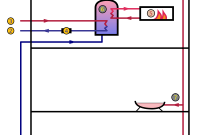How To Install Electric Water Heaters –A Comprehensive Guide: Looking to install electric water heaters? This comprehensive guide will walk you through the step-by-step process of installing electric water heaters, providing you with all the necessary information and tips to ensure a successful installation.
Introduction
Are you tired of running out of hot water during your morning shower? Installing an electric water heater can be a cost-effective solution to this problem. In this guide, we will take you through the process of installing electric water heaters, ensuring that you have a steady supply of hot water whenever you need it. Whether you’re a DIY enthusiast or a homeowner looking to understand the installation process better, this guide is for you.

How to Install Electric Water Heaters
Installing electric water heaters may seem like a daunting task, but with the right tools and a little know-how, it can be a straightforward process. Follow these steps to successfully install your electric water heater:
Step 1: Gather the Necessary Tools and Materials
Before you begin the installation process, it’s essential to gather all the tools and materials you’ll need. Here’s a list of what you should have on hand:
- Electric water heater
- Water heater straps
- Pipe wrench
- Adjustable pliers
- Teflon tape
- Pipe cutter
- Screwdriver
- Drill
- Safety gloves and goggles
- Measuring tape
Step 2: Turn Off the Power and Water Supply
Safety should always be your top priority when working with electricity and water. Start by turning off the power supply to the existing water heater at the circuit breaker. Locate the main water supply valve and shut it off to prevent any water flow.
Step 3: Drain the Water Heater
Before removing the old water heater, you need to drain it. Connect a garden hose to the drain valve and direct the other end to a suitable drainage area. Open the drain valve and let the water flow out. Once the tank is empty, close the drain valve.
Step 4: Disconnect the Old Water Heater
Now it’s time to disconnect the old water heater. Start by disconnecting the water supply lines using a pipe wrench or adjustable pliers. Then, remove the electrical connections, ensuring that the wires are properly labeled for reconnection later.
Step 5: Position the New Water Heater
Carefully position the new electric water heater in the desired location. Ensure that it complies with local building codes, allowing enough space for future maintenance. Use a level to check for proper alignment.
Step 6: Connect the Water Supply Lines
Using Teflon tape, wrap the threads of the water supply lines to create a watertight seal. Connect the cold water supply line to the inlet and the hot water line to the outlet of the water heater. Tighten the connections using a pipe wrench or adjustable pliers.
Step 7: Install the Pressure Relief Valve
Attach the pressure relief valve to the designated opening on the water heater. Ensure that it is properly seated and tightened according to the manufacturer’s instructions.
Step 8: Reconnect the Electrical Wiring
Refer to the manufacturer’s instructions to reconnect the electrical wiring of the new water heater. Double-check that the wires are correctly connected and secure.
Step 9: Fill and Test the Water Heater
Open the main water supply valve to fill the water heater. Once the tank is full, open a hot water faucet in your home to release any trapped air. Check for leaks and tighten any connections if necessary.
Step 10: Turn on the Power
Go back to the circuit breaker and turn on the power supply to the new electric water heater. Verify that it’s functioning correctly by checking
also read:


